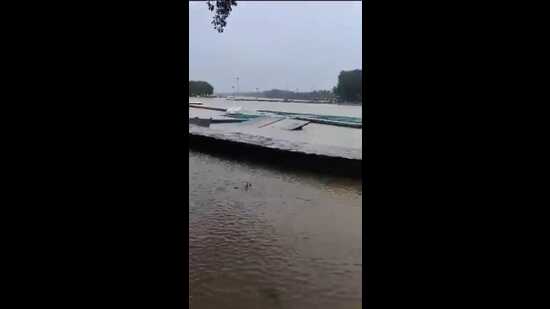302mm rain in 24hours: Sukhna overflows for 1st time in Chandigarh’s history
Chandigarh chief engineer CB Ojha said that the water-level had crossed the danger mark of 1,164-ft in the wee hours of the day and the first floodgate was opened at around 5.35am while the second was opened at 7am.
With Chandigarh witnessing its wettest day in 70 years, recording a whopping 302.2 mm rain in 24 hours, the Sukhna Lake overflowed for the first time in the city’s history, prompting officials to open two floodgates in the early hours of Sunday.

UT chief engineer CB Ojha said that the water-level had crossed the danger mark of 1,164-ft in the wee hours of the day and the first floodgate was opened at around 5.35am while the second was opened at 7am.
While normally, the floodgates are opened only up to a level of around two inches, the authorities had open one at nine inches and the other at seven inches in view of the rising water level in the lake.
While the first floodgate was closed in the evening around 4.45pm, the second remained open at the time of filing of the report.
Ojha said, “We have formed 16 teams, of which one is stationed at the lake to monitor the situation.” The teams are also keeping at close watch at the regulator-end of the lake, he added.
Baltana sees flood-like situation
As water gushed out of the floodgates and entered the Sukhna choe, flooding was seen on its banks and nearby areas in Mohali’s Zirakpur. In Baltana of Zirakpur, a flood-like situation was witnessed with the police post, marriage palaces, municipal park, and cremation grounds, all being submerged.
Meanwhile, the water discharged from check dams over the seasonal rivulet Patiala Ki Rao flooded low-lying areas in Khuda Lahora Colony near the Post Graduate Institute of Medical Education and Research.
Ojha said that the administrations of Chandigarh, Mohali and Panchkula had been alerted before the floodgates were opened. “As a precautionary measure, we also blocked the bridges on Sukhna Choe falling within the city’s jurisdiction,” he said.
He stated there were no reports of flooding along the route of Sukhna Choe in Chandigarh, although the bridges were inundated.
After record-breaking downpour,
expect a comparative lull today
While 302.2 mm rain was recorded between 8:30 am on Saturday and 8:30 am on Sunday, making it the highest-ever record for a 24-hour period in July, Met officials say the intensity of rain will be lower on Monday.
AK Singh, who currently holds the charge of IMD Chandigarh director, explained, “While the monsoon system is active, there is a strong western disturbance which primarily led to rain on Saturday. The confluence of the two systems led to this heavy spell of rain.”
He added that the western disturbance has now passed the region and the intensity of the rains will come down. While residents can expect some rain on Monday too, it’s intensity is expected to be lower, and further go down on Tuesday and Wednesday. From Thursday, however, a spike in monsoon activity is predicted but heavy rains is unlikely.
Officials have, however, sounded a yellow alert for the day.
The second of the four-colour warnings used by IMD, yellow alert asks people to watch and be updated.
Commenting on the downpour over the last two days, Singh said, “This is a very rare instance where a strong western disturbance has affected the region along with an active monsoon system. This is also because of changing climatology. Western disturbances are harder to ascertain and their behaviour is not predictable.”
Before this, the maximum amount of rain in 24 hours in Chandigarh has gone past 200 mm only once. It had never crossed the 300 mm mark before.
Meanwhile, the maximum temperature went down further from 26.5°C on Saturday to 26°C on Sunday, 8.4 degrees below normal. This is the lowest the day temperature has gone in the month of July since 2015 when it had gone down to 25.5°C on July 12. It is also the fourth lowest maximum temperature of all-time recorded by the IMD in the city for the month of July.
The night temperature also dropped from 25.6°C on Saturday to 23.6°C on Sunday, 3 degrees below normal. Over the next three days, the maximum temperature will remain between 27°C and 31°C while minimum temperature will remain between 24°C and 25°C.






